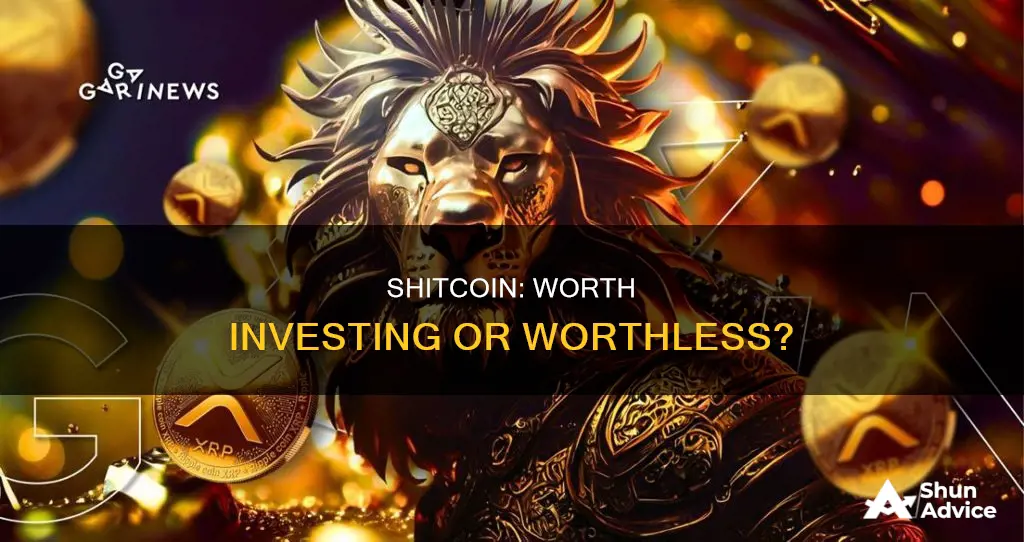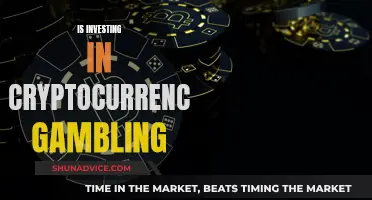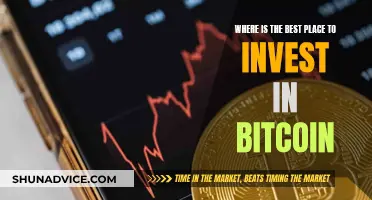
Shitcoin is a term used to describe a cryptocurrency with little to no value or no immediate, discernible purpose. The term is often used to describe valueless altcoins or cryptocurrencies that were developed after Bitcoin became popular. Shitcoins are characterised by short-term price increases followed by sharp decreases, caused by investors who want to capitalise on short-term gains. While the term generally refers to coins without value or purpose, some people invest in them, hoping they will be the next big winner or at least become popular enough to provide some earnings.
| Characteristics | Values |
|---|---|
| Definition | A cryptocurrency with little to no value or no immediate, discernible purpose |
| Value | Based on pure speculation |
| Price Movement | Short-term price increases followed by sharp declines |
| Investor Behaviour | Investors jump on board during price increases and dump their coins at critical points to capitalise on short-term gains |
| Supply | The supply of an altcoin is typically fixed, creating scarcity |
| Risk | High risk of abuse and fraud due to the difficulty in understanding the underlying technology and evaluating the viability of an altcoin |
| Information Sources | Information about altcoins is mostly found on the general internet, making it challenging to determine the accuracy of the information |
What You'll Learn

Shitcoin's value is based on speculation
The term "shitcoin" refers to a cryptocurrency with little to no value or no immediate, discernible purpose. It is a pejorative term used to describe altcoins or cryptocurrencies that were developed after Bitcoin became popular. The value of a shitcoin is often based on speculation as cryptocurrencies have limited practical use. For example, buying and selling real-world goods and services using cryptocurrencies is not yet common.
Shitcoins are characterised by short-term price increases, followed by rapid decreases. This pattern is caused by investors who want to capitalise on short-term gains. The price of a shitcoin may remain relatively level after its launch, but it will increase exponentially over a short period as investors begin to take an interest. This is then followed by a nosedive as investors dump their coins at critical price points.
It can be challenging to identify whether a cryptocurrency is viable or if it was created to defraud investors. The underlying technology used to manage blockchains may not be well understood by many investors, and there is a lot of room for abuse in the cryptocurrency market.
The value of an altcoin depends solely on demand since the supply is fixed. However, because most cryptocurrencies have limited practical use, their values are based on speculation. As a result, a shitcoin is considered valuable simply because it exists.
Shitcoins are easy to identify due to their distinct pattern. While there may be some initial interest in a coin when it is first launched, causing its price to increase, this is often followed by a rapid decrease as investors seek short-term gains.
The development and marketing of altcoins that will eventually be considered shitcoins are unlikely to slow down as long as interest in cryptocurrencies remains high. New coins are constantly being added, aiming to attract capital from unwary investors.
Marvel Silver Coins: A Smart Investment Move?
You may want to see also

Shitcoin's value is diminished by failed investor interest
The term "shitcoin" refers to a cryptocurrency with little to no value or no immediate, discernible purpose. It is a pejorative term often used to describe altcoins or cryptocurrencies that were developed after Bitcoin became popular. Shitcoins are characterised by short-term price increases, followed by rapid decreases, due to investors looking to make quick profits.
The value of a shitcoin is often diminished by failed investor interest. This can occur when a shitcoin fails to meet investor or creator expectations, or does not deliver on the promises made by its developers. As a result, these cryptocurrencies are considered bad investments. The lack of interest and negative sentiment can lead to further price declines, creating a self-fulfilling prophecy.
Shitcoins typically exhibit a specific pattern: they may generate some interest upon their launch, but their price remains relatively stable. However, their price can increase exponentially over a short period as investors jump on board, hoping for quick gains. This is then followed by a sharp decline as these same investors sell their coins at critical price points to capitalise on short-term profits.
It is important to note that the cryptocurrency market is highly speculative, and it can be challenging to identify whether a particular cryptocurrency is viable or just a scam. The lack of government backing and the difficulty in valuing altcoins using traditional economic metrics add to the complexity. Therefore, investing in shitcoins is generally not recommended.
Bitcoin's Volatile Nature: Why You Should Still Invest
You may want to see also

Shitcoin is characterised by short-term price increases followed by nosedives
Shitcoins are easy to identify because they follow this predictable pattern. The price increase is often short-lived, and investors who get in late or hold on too long may end up losing money. This is because shitcoins have little to no intrinsic value and are considered bad investments. The diminished value of a shitcoin is often due to failed investor interest, unmet expectations, or broken promises by developers.
The term "shitcoin" refers to a cryptocurrency with little to no value or no immediate, discernable purpose. It is a pejorative term used to describe altcoins or cryptocurrencies that were developed after Bitcoin became popular. These coins are often characterised by their lack of value, failed investor interest, or unfulfilled promises.
While the specific dynamics behind each shitcoin's price movement may vary, the overall pattern of short-term gains followed by rapid declines remains consistent. Investors who are able to identify this pattern and time their entries and exits accordingly can potentially profit from trading shitcoins. However, it is a risky endeavour due to the volatile nature of these coins.
The cryptocurrency market is highly speculative, and shitcoins are no exception. Their values are based purely on investor sentiment and market speculation, rather than any underlying fundamentals or practical use cases. As a result, shitcoins can be extremely volatile, and their prices can fluctuate wildly in a short period.
Bone Coin: A Wise Investment Decision?
You may want to see also

Shitcoin is a pejorative term for a cryptocurrency with little to no value
Shitcoins are characterised by short-term price increases followed by nosedives caused by investors who want to capitalise on short-term gains. Their prices remain relatively level after launch, but then increase exponentially over a short period as investors jump on board.
Because most cryptocurrencies have limited practical use, their values are based on pure speculation. This means that a shitcoin is something people say is (or isn't) valuable simply because it exists.
Shitcoins are easy to identify because they follow a specific pattern. Although there may be some interest in a coin when it launches, its price remains relatively level. But the price increases exponentially over a short period of time as investors begin to jump on board. This is followed by a nosedive caused by investors who dump their coins at critical price points to capitalise on short-term gains.
Raymond: Avoid Bitcoin for a Stable Financial Future
You may want to see also

Shitcoin is a meme
The term "shitcoin" is a meme in and of itself, often used to describe valueless cryptocurrencies or altcoins that emerged after Bitcoin gained popularity. It refers to a cryptocurrency with little to no value or no clear purpose. The term was popularised by the cryptocurrency community, although the exact origin is unknown.
The "shitcoin" meme is characterised by several defining features. Firstly, it often involves a short-term price surge followed by a rapid decline. This pattern occurs due to investors seeking short-term gains, jumping on board during the initial price increase and then quickly dumping their coins at critical price points, causing a nosedive. Secondly, shitcoins are often associated with failed investor interest. They may fail to meet expectations or deliver on the promises made by their developers, leading to a loss of confidence and value.
The "shitcoin" meme has spawned various images, jokes, and discussions across the internet, particularly on platforms like iFunny and Know Your Meme. It has become a way for people to express their opinions on certain cryptocurrencies, mock unsuccessful investments, or even criticise the broader cryptocurrency market.
While the term "shitcoin" started as a meme, it has gained traction within the cryptocurrency community and is now part of the industry's vernacular. It serves as a cautionary tale for investors, highlighting the speculative nature of most cryptocurrencies and the potential risks associated with investing in them.
Ripple Coins: A Smart Investment Move?
You may want to see also
Frequently asked questions
The term shitcoin refers to a cryptocurrency with little to no value or no immediate, discernible purpose. It is a pejorative term often used to describe altcoins or cryptocurrencies developed after Bitcoin.
The diminished value of a shitcoin is often due to failed investor interest, as it failed to meet investor or creator expectations or didn't deliver on the promises made by developers.
Shitcoins are characterised by short-term price increases followed by sharp declines caused by investors looking to capitalise on short-term gains. Their values are based purely on speculation.
Although there may be initial interest in a shitcoin when it launches, its price remains relatively stable. However, the price increases exponentially over a short period as investors jump on board, followed by a sharp decline as these investors sell at critical price points to capitalise on short-term gains.
It can be challenging to determine whether a cryptocurrency is viable or created to scam investors, especially with the underlying blockchain technology not being well-understood by many investors. Evaluating the value of an altcoin requires a different approach compared to traditional currencies as they are not backed by governments.







